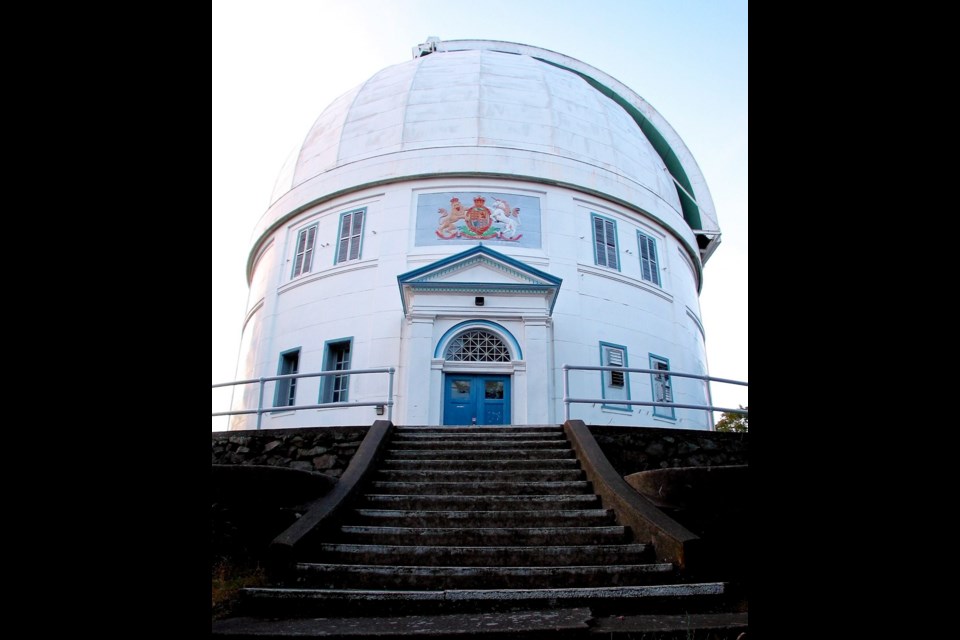This is one of a series of columns by specialists at the Royal B.C. Museum that explore the human and natural worlds of the province.
My research looks at the origins of “big science” in British Columbia. Resolving the fundamental questions of science today involves many nations sharing financial costs, expertise and knowledge.
This is how we approach large questions such as the nature of subatomic matter, cellular biology, mapping DNA, building international space stations or making the next big advance in computing. But where did “big science” begin?
For Canada, the answer is with astronomy. In 1910, astrophysicists were considering the questions raised by new detailed measurements of the spectra of stars. What is the size and shape of the Milky Way? Where is the sun located in the Milky Way? It was with astrophysics that competing theories could be tested or refined. The world needed data.
One of the problems was that distant stars were difficult to see. The limit of existing instruments had been reached. The answers lay with fifth-magnitude or faint stars. Using refracting prisms to break down the light and record it as a spectrograph, a star’s chemical composition could be studied. The movement of dark bands could be used to calculate movement or radial velocity away from the observer. But to gather this data would require the most sophisticated telescope in the history of the world.
It was Canada that committed to build such a telescope in 1913. Although it would be superseded by even larger telescopes, Canada’s commitment to big science and to the international community began with the quest to build the instrument that would be installed in Saanich on Little Saanich Mountain.
It is a dramatic story, and Canada kept its commitments despite the First World War. It also involved a very unusual man who never dreamed he would become a renowned astronomer. John Stanley Plaskett (1864-1941) was born on a farm, in Hickson, outside Woodstock, Ont.
A cheerful and hard-working man, he had a unique aptitude for mathematics and mechanical engineering. He learned applied engineering at the Edison Electric Co. before returning to Canada in 1890 as an assistant, building test equipment for the physics department at the University of Toronto.
In 1903, when Canada’s dominion astronomer, W.F. King, needed a project manager to complete a new refracting telescope for Ottawa’s new Dominion Observatory, Plaskett was recommended.
King had a remarkable gift for recognizing talent and giving it free rein. He encouraged Plaskett, who flourished, detecting design flaws and dramatically improving the new telescope. He was 40 when he became an astronomer. Five years later, he represented Canada on international astronomy committees, examining technical challenges.
The lack of precise data on radial velocities, the movement of stars, was a key issue for astrophysics. He and King saw an opportunity. Canada could make a fundamental contribution to our understanding of the universe.
In 1913, their lobbying succeeded. Canada agreed to fund pure research and undertake the challenge to build the world’s largest telescope, a 1.8-metre (or 72-inch) instrument. It would not be easy.
The search for an ideal location for the new instrument took two years and hundreds of careful readings on daily and seasonal temperature variation, “seeing” conditions, such as cloud cover, and issues influencing stable, precise observation. The site outside Victoria was ultimately selected for its “perfect climate,” at least compared to others such as Ottawa, Banff and Penticton.
The project fired the imagination of B.C. Premier Richard McBride. His government agreed to assist with the assembly of the land and fund the construction of a road to the summit.
The great telescope would become one of the region’s most popular tourist destinations. That aspect also solidified the idea of making science accessible to the ordinary citizen. That tradition continues today.
The great instrument makers of the world competed for the contract to build the instrument to the specifications set by Plaskett. The two-tonne glass mirror left Belgium only days before the outbreak of the First World War. It went to Pittsburgh, where it took several more years to grind and polish it to perfection. Would the government cancel the project due to the war? There was drama in this story.
The telescope was ready in October 1916, but flaws delayed the mirror for 18 months. On May 6, 1918, “first light” was captured by the great telescope. The work of gathering the data to test theory began at a furious pace.
By 1923, a catalogue of 500 stars had been published, based on hundreds of observations. Eventually, galaxies, binary stars (pairs of suns that orbit each other), gas clouds and the nature of matter in deep space would also be studied.
After Plaskett’s death, new questions would be explored by the telescope: Supporting global research on dark matter and black holes, locating mysterious sources of X-rays, tracking the threat of asteroid trajectories to Earth and gravity waves. A century later, Canada’s investment continues to contribute to big science and our understanding of the universe.
In 2018, we will mark a century of contributions by our own Dominion Astrophysical Observatory. The Royal B.C. Museum, in partnership with the National Research Council’s Dominion Astrophysical Observatory, will unveil the results of my research in a small exhibit to mark a century of contributions to our knowledge of the universe, timed to coincide with a major astronomy conference.
Lorne Hammond, curator of history at the Royal B.C. Museum, joined the museum in 1997 after completing a history doctorate at the University of Ottawa. His research with the museum collection helps to develop exhibits. Subjects of his research on British Columbia’s energy history include the Columbia River Treaty, oil-tanker debates of the 1970s and our first natural gas pipeline.



